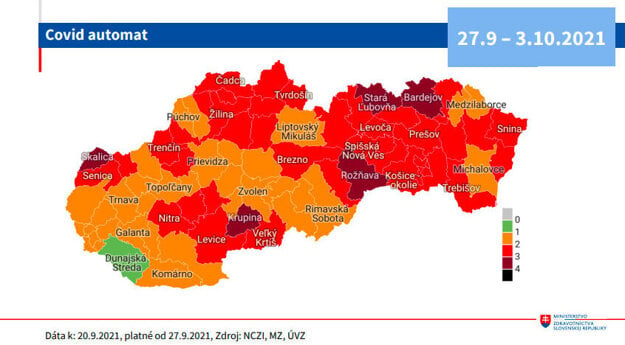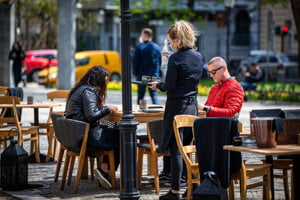The pandemic situation in Slovakia is deteriorating relatively quickly. While last week, there were some 550 new daily cases, this week it was about 900.
Our paywall policy:
The Slovak Spectator has decided to make all the articles on the special measures, statistics and basic information about the coronavirus available to everyone. If you appreciate our work and would like to support good journalism, please buy our subscription. We believe this is an issue where accurate and fact-based information is important for people to cope.
“We expect that registering 1,000 new cases a day will be common next week,” said Matej Mišík, head of the Institute for Health Analyses, running under the Health Ministry.
Given the worsening situation and the rising number of patients in hospitals, several facilities started reprofiling their beds on Monday. This concerns mostly hospitals in Košice Region, Prešov Region, Banská Bystrica Region and Nitra Region, said Health Minister Vladimír Lengvarský (OĽaNO nominee).
Papal visit had little impact
The daily caseload is impacted mostly by the spread of the virus at schools. There is quite an increase in the positive cases among schoolchildren and their parents, Mišík said.
This week, 851 out of almost 53,000 classrooms switched to remote education. Lengvarský said that in some cases, classrooms had to be closed because children came into contact with an unvaccinated and infected teacher. He stressed, though, that the government wants to keep schools open as long as possible.
Mišík also warns against big parties, like weddings, that have created hotspots in several districts.
 Slovakia braces for third Covid wave as Health Ministry warns of infection peak in October Read more
Slovakia braces for third Covid wave as Health Ministry warns of infection peak in October Read more Meanwhile, some 8 to 9 percent of detected cases require hospitalisation. The situation in hospitals differs from the regional point of view, with most people being hospitalised in eastern Slovakia.
From the share of patients occupying hospitals beds compared with the previous wave, the highest share is in Ilava (Trenčín Region), where beds reserved for Covid patients are filled to 40 percent of the previous wave’s maximum.
How big of an impact the mid-September visit of Pope Francis would have on the spread of the virus was a topic of concern, but Lengvarský said that it has not had a very significant effect.
Only one green district
 The map of districts from Monday, September 27, 2021. (Source: Health Ministry)
The map of districts from Monday, September 27, 2021. (Source: Health Ministry)The deteriorating situation is also reflected on the map of districts that apply measures based on the alert system, known as Covid automat.
Five districts will be placed in the dark red tier next Monday, September 27, while another 39 will be in the red tier, 34 in the orange tier, and only one (Dunajská Streda) in the green tier with the least strict rules. In practice, this means that in the majority of districts, people will not be allowed to sit inside restaurants and similar facilities without a negative test result or proof of vaccination.
 Unvaccinated people face extensive restrictions in several districts Read more
Unvaccinated people face extensive restrictions in several districts Read more The situation has worsened in altogether 19 districts in comparison to last week. The virus is reportedly spreading at a fast rate in 14 districts (Bardejov, Bytča, Čadca, Dolný Kubín, Košice I-IV, Krupina, Senica, Skalica, Stará Ľubovňa, Žarnovica, and Žilina).
In 10 districts (Bardejov, Čadca, Dolný Kubín, Košice, Krupina, Námestovo, Senica, Skalica, Stará Ľubovňa, and Žarnovica), the rate of positive tests in relation to the total number of tests exceeds 15 percent.
Tiers of districts starting September 27
Districts at Warning Level 2 (dark red)
Bardejov • Krupina • Rožňava • Skalica • Stará Ľubovňa
Districts at Warning Level 1 (red)
Bánovce nad Bebravou • Brezno • Bytča • Čadca • Dolný Kubín • Gelnica • Humenné • Ilava • Kežmarok • Košice I-IV • Košice-okolie • Kysucké Nové Mesto • Levice • Levoča • Martin • Myjava • Námestovo • Nitra • Poprad • Prešov • Revúca • Ružomberok • Sabinov • Senica • Snina • Sobrance • Spišská Nová Ves • Svidník • Trebišov • Trenčín • Tvrdošín • Veľký Krtíš • Vranov nad Topľou • Žarnovica • Žilina • Zlaté Moravce
Districts at Alert Level (orange)
Banská Bystrica • Banská Štiavnica • Bratislava I-V • Detva • Galanta • Hlohovec • Komárno • Liptovský Mikuláš • Lučenec • Malacky • Medzilaborce • Michalovce • Nové Mesto nad Váhom • Nové Zámky • Partizánske • Pezinok • Piešťany • Poltár • Považská Bystrica • Prievidza • Púchov • Rimavská Sobota • Šaľa • Senec • Stropkov • Topoľčany • Trnava • Turčianske Teplice • Žiar nad Hronom • Zvolen
Monitoring (green)
Dunajská Streda
More about the coronavirus developments in Slovakia:
- Measures valid in Slovakia as of August 16
- How to travel to and from Slovakia during Covid-19
- Statistics of the positive coronavirus cases
- Do I have the new coronavirus? How to proceed if you have a suspicion
- I encountered a person who is COVID-19 positive. What do I do next? (FAQ)
- When will I get my COVID vaccine? FAQs about vaccination in Slovakia






